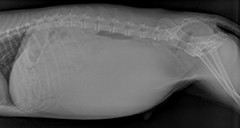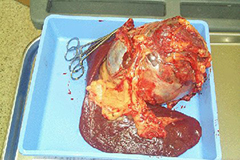Splenic hematoma and nodular hyperplasia are the most common non-cancerous lesions found in the spleen and account for 20–41% of all splenic lesions. They are benign nodules/masses of clotted blood. Surgical removal is curative.
Hemangiosarcoma is a common malignant tumor of the spleen usually seen in older dogs (8–10 years of age). Any large breed dog appears to be at an increased risk especially German Shepherds, Golden Retrievers, Labradors, and Poodles.
Signs associated with splenic masses can be subtle and include weakness or may be more obvious e.g. collapse and sudden death if the mass ruptures and bleeds internally. Mucous membranes, such as the gums, may be pale and heart and respiratory rates can be increased. Other signs can include
- abdominal distension
- weight loss
- inappetence
- fainting or weakness

Your primary-care veterinarian may run several tests to obtain a presumptive diagnosis and to prepare for surgery. These may include blood tests, urinalysis, a clotting profile, examination of fluid obtained from the abdomen, and chest and abdominal radiographs (Figure 1). Abdominal ultrasound is another useful method to identify and characterize masses in the abdomen as well as look for free fluid or blood. Echocardiography (ultrasound of the heart) may be recommended as some dogs may have tumor spread to the heart.

Surgery is the primary method of treatment for dogs with splenic masses. This involves removal of the spleen (splenectomy). Removal of the spleen is preferred to a biopsy as it serves as both a diagnostic and therapeutic procedure (Figure 2). Patients are stabilized prior to surgery. This may require fluid therapy or a blood transfusion and intensive care monitoring.
The final diagnosis relies on microscopic examination the mass after surgical removal. Splenic hematomas and hemangiomas as well as other benign disease can have a similar clinical presentation and must be differentiated from hemangiosarcoma. Up to 2/3 of dogs with splenic masses have a malignant tumor (2/3 of these are hemangiosarcoma). Dogs with a ruptured splenic mass requiring a blood transfusion are more likely to be diagnosed with hemangiosarcoma. The remaining patients have benign masses that are effectively treated with splenectomy.
Your dog’s activity should be restricted to short leash walks only during the first two weeks of healing. Your dog may need to wear an E-collar or tee shirt to prevent self-trauma to the surgical site.
Benign splenic masses are effectively cured with surgery. Unfortunately, survival times with surgery alone for dogs with hemangiosarcoma may be 2–3 months or less. One year survival is less than 10%. Ultimately dogs die from metastatic disease. Chemotherapy may increase survival times up to 6–8 months.
Complications that may be associated with surgery include hemorrhage (ongoing bleeding), cardiac arrhythmias (irregular heart rhythm), and pancreatitis (often manifested by vomiting). An ECG to look for arrhythmias is recommended after surgery. While this may require treatment, most arrhythmias resolve within 24–48 hours.
Photos provided courtesy of Elizabeth Hardie, DVM, PhD, Diplomate ACVS.













